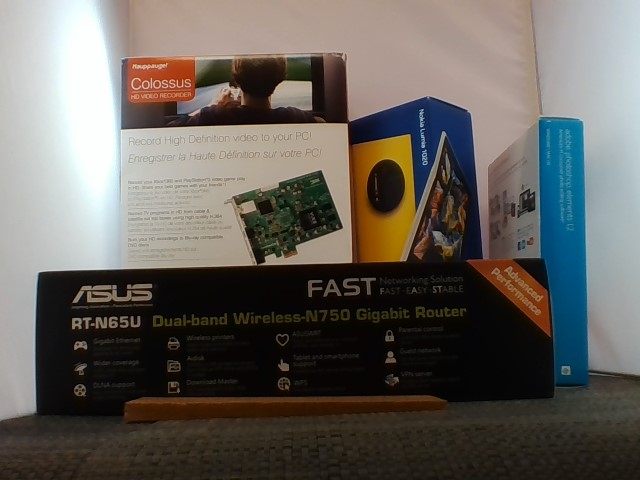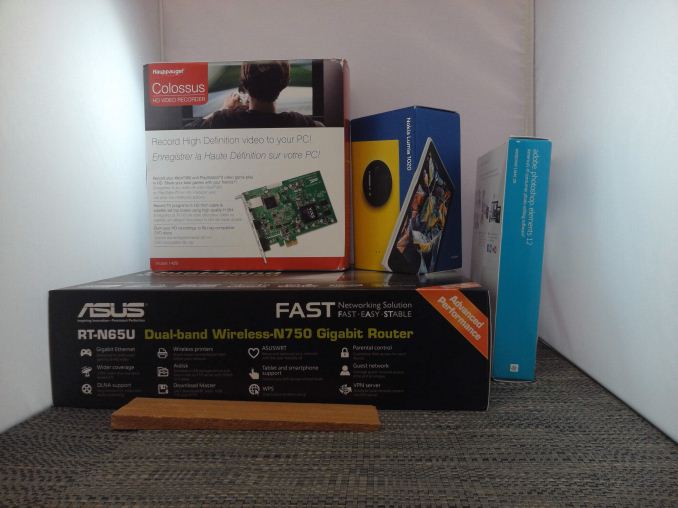The Dell Venue 11 Pro 7000 Review
by Brett Howse on April 16, 2015 8:00 AM EST- Posted in
- Tablets
- Dell
- Windows 8.1
- Core M
Camera
The Venue 11 Pro has two cameras. The front camera is a 2 MP unit and the rear camera is an 8 MP sensor. Neither are particularly impressive cameras unfortunately. Either would be ok for a video conference or something like that, but the camera quality is pretty low.
Here are some sample pictures.
Venue 11 Pro Front Camera Sample
Venue 11 Pro Rear Camera Sample
It seems to be the thing to do to include cameras in tablets. If you needed to do a video chat, they would suffice, but they are not very good for imaging.
Wi-Fi
The Venue 11 Pro comes with the Intel Dual Band Wireless-AC 7265 wireless adapter, which is a 2x2:2 802.11ac model. We have seen it in quite a few devices since it was released late last year, superseding the 7260 model. It has a maximum connection speed of 866 Mbps.

The Venue 11 Pro did not have the best network performance. Even with the latest driver, the maximum connection speed that it would achieve was 780 Mbps, so right away there is a bit of an issue with the reception since it is not achieving the maximum speed of the adapter even with it being the only wireless device connected to the router. During use, the maximum transfer speed was only 420 Mbps though, which is an average result for this model, however it would not consistently deliver these speeds, with it sometimes dropping to the mid 200 Mbps range.
The tablet dock does allow for a wired connection, however the dock is only a 10/100 Mbps Ethernet port.
Speakers
Dell has two speakers which, like their XPS 13, are mounted on the sides of the device. This gives a good bit of stereo separation as well as helps with directing sound towards your ears, as opposed to devices where the speakers fire towards the rear. Like many devices these days, they are tuned with Waves MaxxAudio.
The speakers were surprisingly loud, with a measured SPL of 76 dB (A Weighted) when playing music. Looking at the frequency response, there is actually reasonable response at the lower end of the graph which is always difficult for smaller speaker drivers to achieve. However there is a big dip around 4500 Hz which spoils the otherwise decent results.
Software
The Venue Pro 11 is of course a Windows based tablet, and as such is restricted somewhat when used as a tablet by the Windows Store, which, several years in, still does not have a fully fleshed out app store, but it has improved quite a bit. On the productivity and business side, Microsoft has made some headway here with partnerships with companies such as Dropbox and Salesforce.
On the tablet side only, there is certainly a gap with the lack of Microsoft Office, although that has been previewed as part of the Windows 10 update coming later this year. Buying the device today though means that you are missing out on the touch version.
OneNote is available as a touch version though, and with the inclusion of an active stylus, the Venue 11 Pro can be a formidable device for taking notes. I attempted to write something for a screenshot, but my handwriting is so poor that I felt it would be best to not embarrass myself. Instead I fired up Fresh Paint and did a bit of coloring with the stylus. It is very accurate and works well for this. People that have tablets that include a stylus seem to swear by them, and it seems to be for good reason.
I only colored some of this fish...
As an enterprise device, the Dell offers many of the features that an Information Technology department would look for, including Intel vPro on the 5Y71 version, and Dell Client Command Suite to streamline system deployment, monitoring, and updating.
The 10.8 inch display also does a good job with desktop use, especially when paired with some of the optional accessories like the stylus or keyboards. The Core M processor also performs better than any other tablet CPU which is fanless, which means that typical office tasks are no problem. Certainly the smaller display size can be an issue on desktop use compared to a much larger display, but those that are used to smaller notebooks will not find the Venue 11 Pro much more cramped. It would realy benefit here from a less wide aspect ratio though, as 16:9 is really not ideal for office use.














92 Comments
View All Comments
MrSpadge - Thursday, April 16, 2015 - link
Well Said! I'm not going to buy Core M because I value performance over mobility - yet this doesn't make it a bad product. If you want maximum performance at high mobility, nothing comes close to Core M.dj_aris - Thursday, April 16, 2015 - link
Core M is in fact a new cpu category on it's own, a cpu that resembles the single core performance of "core" cpus while in the Atoms' TDP envelope (at least before it throttles!). But, as with every new product, it's overpriced at launch. Wait for the Skylake release, I say.lilmoe - Thursday, April 16, 2015 - link
That's the main point. It's REALLY overpriced.xthetenth - Thursday, April 16, 2015 - link
Pay a pretty high price for the absolute best burst performance for a snappy device. I've heard much worse than that.smilingcrow - Thursday, April 16, 2015 - link
The M-5Y71 is the same price as the i5-4300U in my laptop with the same base & turbo boost clocks for the CPU. Given the same cooling as my laptop has it should perform very similarly for CPU loads. Not fussed about GPU loads so haven't focussed on that but seemingly it will struggle to match the U series when both are stressed.Marc GP - Thursday, April 16, 2015 - link
A category where they can only keep this performance for short bursts before having to low their frequency from 2,8Ghz (turbo) to their nominal 1Ghz (where you don't get any much performance than on a simple Atom).ppi - Thursday, April 16, 2015 - link
Even in the benchmarks, where sustained performance is necessary, Core-M is some 25% slower compared to 15W Broadwell. ONLY.This effectively means, that if task is pain on Core-M, it will be pain on 15W Broadwell as well. I.e. if some task is not snappy and requires waiting on Core-M, it requires waiting on Broadwell as well. And only desktop class chips may have the oomph to be significantly faster.
I do not count in games, but nobody considers Broadwell-U gaming SoC either.
smilingcrow - Thursday, April 16, 2015 - link
If you had read the recent detailed Anandtech overview of Core M you would see that is a fallacy. I was surprised how well Core M does in a fanless laptop versus one with a Broadwell i5 that is fan cooled. And even more how well it does in a tablet where surface temperate is more of an issue so throttling is more prevalent.A Core M-5Y71 in my Latitude E7440 with a slightly beefier cooler would I imagine come close to my i5-4300U even for extended loads. This is purely for CPU loads as the GPU is another issue that doesn’t concern me.
MrSpadge - Thursday, April 16, 2015 - link
When it throttles it's actually entering Atoms TDP envelope. Before that it's allowed to use more power for short periods. That's the whole point of a Thermal Design Power.zepi - Thursday, April 16, 2015 - link
If you don't care about absolute performance, Intel is happy to sell you a Baytrail for quite a bit cheaper.If you do... Well, no one else can match Core M's CPU-performance even remotely.